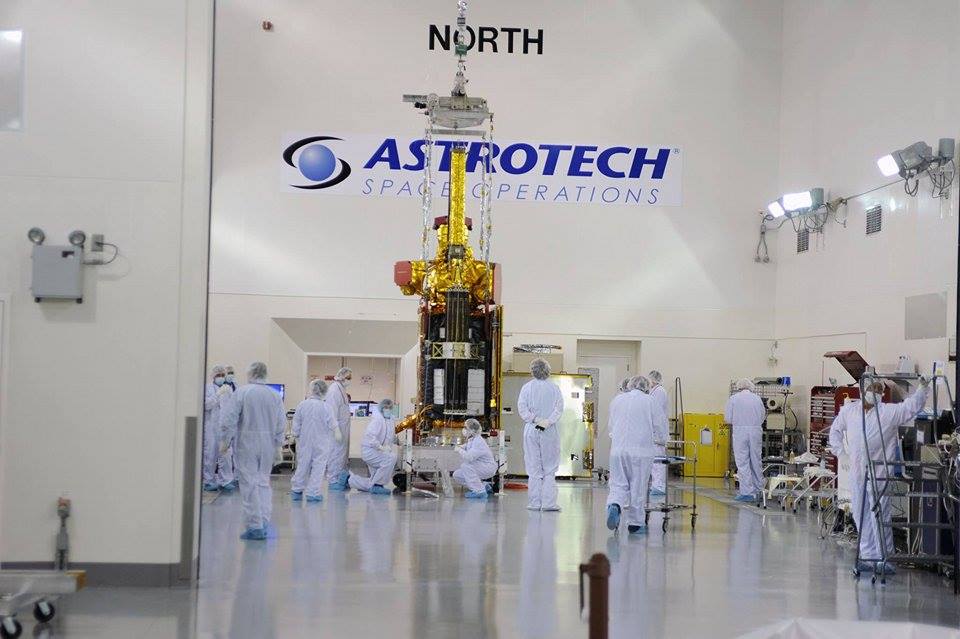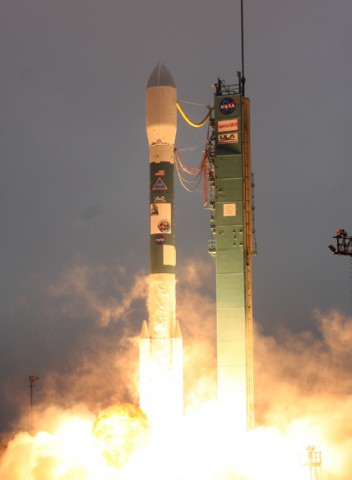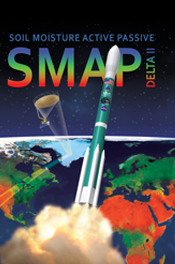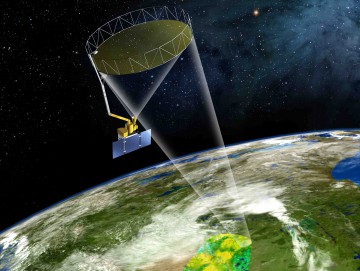
For the 153rd time in its quarter-century of operational service, the thunderous roar of a Delta II booster will rattle Vandenberg Air Force Base, Calif., on Thursday, 29 January, carrying NASA’s Soil Moisture Active Passive (SMAP) spacecraft into a near-circular orbit of about 425 miles (685 km), inclined 98.116 degrees to the equator. Liftoff of the Delta II—which is flying under the auspices of Centennial, Colo.-based United Launch Alliance (ULA)—is scheduled to occur from Vandenberg’s Space Launch Complex (SLC)-2 during a 180-second “window”, which opens at 6:20:42 a.m. PST. It will be the second of 13 missions planned by ULA in 2015 and comes hard on the heels of last week’s highly successful MUOS-3 flight. When it attains operational status, SMAP will become one of NASA’s first Earth observation satellites in response to the National Research Council’s Decadal Survey.
Thursday’s mission—for which weather conditions at the mountain-ringed California launch site are anticipated to be 80-percent favorable—marks the 52nd NASA payload for the Delta II and its 43rd launch from SLC-2, coming just six months after one of its siblings lofted the Orbiting Carbon Observatory (OCO)-2 from the same site. First flown in February 1989, the earliest incarnation of the Delta II was fabricated by McDonnell Douglas and, following the company’s merger with Boeing in 1997, by Boeing Integrated Defense Systems and, most recently, by ULA since the latter’s formation in December 2006. Today, U.S. government payloads which require the lifting capability of the Delta II are supported by ULA, whilst Boeing Launch Services oversees missions in the commercial sector.
In the immediate aftermath of the January 1986 loss of Challenger, plans to gradually phase out U.S. expendable launch vehicles in favor of the shuttle were abandoned and the reliable Delta—with an ancestry stretching back to the very dawn of the Space Age—was brought back into production as the Delta II. It made its inaugural mission on St. Valentine’s Day in 1989, delivering a Global Positioning System (GPS) Navstar satellite into orbit, and over the next two decades it also delivered seven orbiters and landers towards Mars, including the two Mars Exploration Rovers (MER), Spirit and Opportunity, in the summer of 2003. The Delta II also lofted the Near-Earth Asteroid Rendezvous (NEAR) in February 1996, the Genesis solar wind sample-return spacecraft in August 2001, the ill-fated Comet Nucleus Tour (CONTOUR) in July 2002, the Spitzer Space Telescope in August 2003, the Mercury Surface, Space Environment, Geochemistry and Ranging (MESSENGER) mission to Mercury in August 2004, Deep Impact in January 2005, Dawn in September 2007 and the Kepler observatory in March 2009. Additionally, it has transported several dozen Iridium communications satellites into orbit.

In spite of a partial failure to deploy KoreaSat-1 into geostationary orbit in August 1995, due to the failure of one of its Solid Rocket Motors (SRMs) to separate properly, and a catastrophic explosion, just 13 seconds after liftoff, in January 1997, which destroyed the first GPS Block IIR satellite, the Delta II has a virtually unblemished record and retains a proud heritage as one of the most reliable launch vehicles currently in active operational service, with a success rate in excess of 99.3 percent.
Original plans called for the Delta II to be phased out of service in 2011, following Air Force plans to discontinue use of the booster. However, that September, NASA announced that it had added the Delta II to its NASA Launch Services (NLS)-II contract, which provided for the delivery of payloads weighing about 550 pounds (250 kg) into minimum circular orbits of 125 miles (200 km). Additionally, four scientific missions—OCO-2, SMAP, and the forthcoming Ice, Cloud and Land Elevation Satellite (ICESat)-2 and Joint Polar Satellite System (JPSS)—received firm bookings for Delta II launches.
In traditional style, the vehicle for the SMAP mission has received a four-digit Delta designation of “7320”, exactly the same configuration as was used on last July’s OCO-2 launch. This describes its membership of the 7000-series of the Delta II (“7”), its trio of strap-on SRMs (“3”), the presence of a second stage (“2”) and the absence (“0”) of a third stage. Fabrication of the booster took place at ULA’s Decatur, Ala., facility, after which its primary components—the Payload Fairing (PLF), the Inter-Stage Adapter (ISA) and the first and second stages—were delivered to Vandenberg in July 2014 and transported to the Horizontal Processing Facility (HPF) at the SLC-2 site. Erection and mating of the components took place through August, originally tracking a 5 November launch, but this was slipped until 29 January 2015, due to the need for additional testing of the SMAP spacecraft’s reflector boom assembly.
Finally, on 15 October, the 2,080-pound (945 kg) SMAP spacecraft arrived by truck at the Astrotech payload processing facility at Vandenberg, having traveled from NASA’s Jet Propulsion Laboratory (JPL) in Pasadena, Calif. Initial checkout was followed by the fueling of its attitude control system with hydrazine, the loading and exercising of its flight software and the precise weighing of the spacecraft. In late November, the ultra-lightweight mesh antenna for use by the spacecraft’s active Synthetic Aperture Radar (SAR) and passive radiometer was installed and tested. Elsewhere, the Delta II’s second stage was positioned atop the first stage and its hypergolic propellants of nitrogen tetroxide and a 50-50 combination of hydrazine and unsymmetrical dimethyl hydrazine (known as “Aerozine-50”) were loaded. Due to their highly corrosive nature, after loading it is imperative that the Delta II must launch within 37 days; failure to do so would require destacking and refurbishment or removal of the entire 19.4-foot-tall (5.9-meter) second stage.

On 12 January, SMAP was installed into its transport canister and integrated with the Delta II the following day. Combined systems tests were successfully performed between the payload and the booster and early last week the two-piece (or “bisector”) PLF was closed around the spacecraft. Yesterday (Tuesday), NASA and ULA managers met at Vandenberg for the Launch Readiness Review (LRR), which concluded with a unanimous “Go” to proceed with an opening launch attempt at 6:20:42 a.m. PST Thursday. Although weather conditions are expected to be 80-percent favorable for tomorrow’s liftoff, SMAP carries Western Range clearance for a backup opportunity during another 180-second “window”, also opening at 6:20:42 a.m., on Friday. Both opportunities will see the Delta II launch about 42 minutes before local sunrise, offering spectacular views to observers and photographers on the West Coast.
Countdown operations will get underway late Wednesday evening, when the Mobile Service Tower (MST) rolls back to its launch position, about nine hours before T-0. Five hours later, terminal countdown operations will commence, with liquid oxygen being pumped into the booster’s first stage a little under two hours ahead of launch. With the first stage fully loaded with liquid oxygen and a highly refined form of rocket-grade kerosene (known as “RP-1”), the automated countdown will kick off at T-4 minutes.
Three seconds before liftoff, the single RS-27A main engine of the first stage will roar to life, producing 200,000 pounds (90,700 kg) of thrust at sea level. This Rocketdyne-built engine will support the Delta II for the first 4.5 minutes of ascent. Strapped around the base of the first stage, the trio of 42-foot-long (12.8-meter) SRMs will ignite at T-0. Together with the RS-27A main engine, and a pair of verniers for roll controllability, these will power the Delta II stack away from SLC-2 and establish it onto the proper flight azimuth of 196 degrees, for the precise injection of SMAP into its 98.116-degree-inclined orbit.
By 35 seconds into Thursday morning’s flight, the vehicle will pass Mach 1, and at 50.3 seconds it will encounter a period of maximum aerodynamic stress on its airframe, a phenomenon known as “Max Q”. The three SRMs will exhaust their powder-based solid fuel and burn out at T+64.7 seconds, but will remain attached to the rapidly ascending Delta II for more than half a minute, before finally being jettisoned at T+99 seconds. After this point, the RS-27A engine will continue to burn hot and hard, shutting down at T+261.8 seconds, some 4.5 minutes after leaving Vandenberg Air Force Base. Its role in the mission now complete, the first stage—which measures 87 feet (26.5 meters) in length—will be jettisoned shortly afterward, making way for the ignition of the Aerojet-built AJ-10-118K second stage engine at T+276 seconds.

Unlike the RS-27A, the Aerojet engine is capable of being restarted in flight and will support two discrete “burns” to deliver SMAP into orbit. Capable of producing 9,850 pounds (4,470 kg) of propulsive yield, the AJ-10-118K is fed by a hypergolic mix of nitrogen tetroxide and Aerozine-50. Its propellant tanks are insulated by “blankets” of Dacron and Mylar. The second stage also houses an inertial platform and guidance system to control all critical phases of the flight. Less than half a minute into the first burn, at T+295 seconds, the 27.9-foot-tall (8.5-meter) PLF—responsible for protecting SMAP from aerodynamic, thermal and acoustic stresses in the lower atmosphere—will be jettisoned, exposing the satellite to the space environment for the first time.
The second stage engine will shut down for its First Cutoff (known as “SECO-1”) at T+643.6 seconds, about 10.5 minutes after departing Vandenberg. It will then coast for the next 41 minutes, ahead of the First Restart at T+3098 seconds, almost 52 minutes into the mission. This second burn will last 12.1 seconds, ending with SECO-2, and will be followed by another period of coasting—lasting 300 seconds, or exactly five minutes—preparatory to the separation of the SMAP satellite at T+3410.5 seconds. Assuming that all planned milestones are met, NASA’s soil moisture watcher will be released into orbit about 56 minutes and 50 seconds after launch.

This will begin the Soil Moisture Active Passive mission, which is expected to run for about three years, providing the most accurate and highest-resolution measurements of soil moisture ever obtained from space and detecting whether the ground is frozen or thawed. This is expected to greatly enhance scientists’ knowledge of the processes linking Earth’s water, energy and carbon cycles. Key beneficiaries of SMAP data include hydrologists, weather forecasters, climatologists and agricultural and water resource managers, although the spacecraft is expected provide important assistance in tracking and mitigating fire hazards, floods and disease control.
One of SMAP’s most obvious features is its ultra-lightweight mesh antenna, built by Northrop Grumman, which weighs just 56 pounds (25 kg) and will deploy to a diameter of 19 feet (6 meters) and revolve about the Earth-facing (or “nadir”) axis at 14.6 rpm, thereby providing a conically scanning beam and a surface incidence angle of 40 degrees, which covers a swath width of 620 miles (1,000 km) of Earth’s surface. This will provide global coverage of soil moisture every three days at the equator and every two days at boreal latitudes, above 50 degrees North. Utilizing the mesh antenna will be SMAP’s active SAR and passive radiometer, operating in the L-band range (1.20-1.41 GHz), which will observe clouds and moderate vegetation in order to measure the presence of water in the topmost 2 inches (5 cm) of the soil.
Want to keep up-to-date with all things space? Be sure to “Like” AmericaSpace on Facebook and follow us on Twitter: @AmericaSpace
Missions » SMAP »


